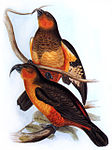Nestor (genus)
Tampilan
| Nestor | |
|---|---|

| |
| Kākā (Nestor meridionalis) | |
| Klasifikasi ilmiah | |
| Kerajaan: | |
| Filum: | |
| Kelas: | |
| Ordo: | |
| Famili: | |
| Subfamili: | |
| Tribus: | Nestorini
|
| Genus: | Nestor Lesson, 1830
|
| Spesies | |
|
N. notabilis | |
Genus Nestor, satu-satunya genus bangsa Nestorini, terdiri dari dua spesies bayan dari Selandia Baru dan satu spesies yang telah punah dari Pulau Norfolk, Australia.
Daftar spesies
- Kea, Nestor notabilis
- Kākā, Nestor meridionalis
- Kākā Pulau Utara, Nestor meridionalis septentrionalis
- Kākā Pulau Selatan, Nestor meridionalis meridionalis
- Kākā Pulau Norfolk, Nestor productus (punah)
| Nestorini | |||
|---|---|---|---|
| Common name (binomial name) status |
Image | Description | Range and habitat |
| Kea (Nestor notabilis) |
 |
48 cm (19 in) long. Mostly olive-green with scarlet underwings and rump. Dark-edged feathers. Dark brown beak, iris, legs, and feet. Male has longer bill.[2] | New Zealand: South Island High-level forests and subalpine scrublands 850–1400 m AMSL.[3] |
| South Island Kaka (Nestor meridionalis meridionalis) |
 |
Similar to the North Island Kaka, but slightly smaller, brighter colours, the crown is almost white, and the bill is longer and more arched in males.[5] | New Zealand: South Island Unbroken tracts of Nothofagus and Podocarpus forests 450–850 m AMSL in summer and 0–550 m in winter.[3] |
| North Island Kaka (Nestor meridionalis septentrionalis) |
 |
About 45 cm (18 in) long. Mainly olive-brown with dark feather edges. Crimson underwings, rump, and collar. The cheeks are golden/brown. The crown is greyish.[5] | New Zealand: North Island Unbroken tracts of Nothofagus and Podocarpus forests between 450–850 m AMSL in summer and 0–550 m in winter.[3] |
| Norfolk Kaka |
 |
About 38 cm long. Mostly olive-brown upperparts, (reddish-)orange cheeks and throat, straw-coloured breast, thighs, rump and lower abdomen dark orange.[7] | Formerly endemic on Norfolk Island and Phillip Island of Australia[8] Rocks and trees[7] |
| Chatham Kaka (Nestor sp.) |
Appearance unknown, but bones indicate reduced flight capability. | Only known from subfossil bones.[9] | Formerly endemic on Chatham Island of New Zealand Forests[9] |
Referensi
- ^ BirdLife International (2008). "Nestor notabilis". IUCN Red List of Threatened Species. Version 2008. International Union for Conservation of Nature. Diakses tanggal 24 December 2008. Database entry includes a range map and justification for why this species is endangered.
- ^ "Kea - BirdLife Species Factsheet". BirdLife International. 2008.
- ^ a b c Juniper, Tony (1998). Parrots: A Guide to Parrots of the World. Yale University Press. ISBN 978-0300074536.
- ^ a b BirdLife International (2008). "Nestor meridionalis". IUCN Red List of Threatened Species. Version 2008. International Union for Conservation of Nature. Diakses tanggal 24 December 2008. Database entry includes a range map and justification for why this species is endangered.
- ^ a b "Kaka - BirdLife Species Factsheet". BirdLife International. 2008.
- ^ BirdLife International (2008). "Nestor productus". IUCN Red List of Threatened Species. Version 2008. International Union for Conservation of Nature. Diakses tanggal 24 December 2008. Database entry includes a range map and justification for why this species is endangered.
- ^ a b Forshaw, Joseph M. (1981) [1973, 1978]. Parrots of the World (edisi ke-corrected second edition). David & Charles, Newton Abbot, London. ISBN 0-7153-7698-5.
- ^ "Norfolk Island Kaka - BirdLife Species Factsheet". BirdLife International. 2008.
- ^ a b c Millener, P. R. (1999). "The history of the Chatham Islands' bird fauna of the last 7000 years – a chronicle of change and extinction. Proceedings of the 4th International meeting of the Society of Avian Paleontology and Evolution (Washington, D.C., June 1996)." Smithsonian Contributions to Paleobiology. 89: 85–109.
